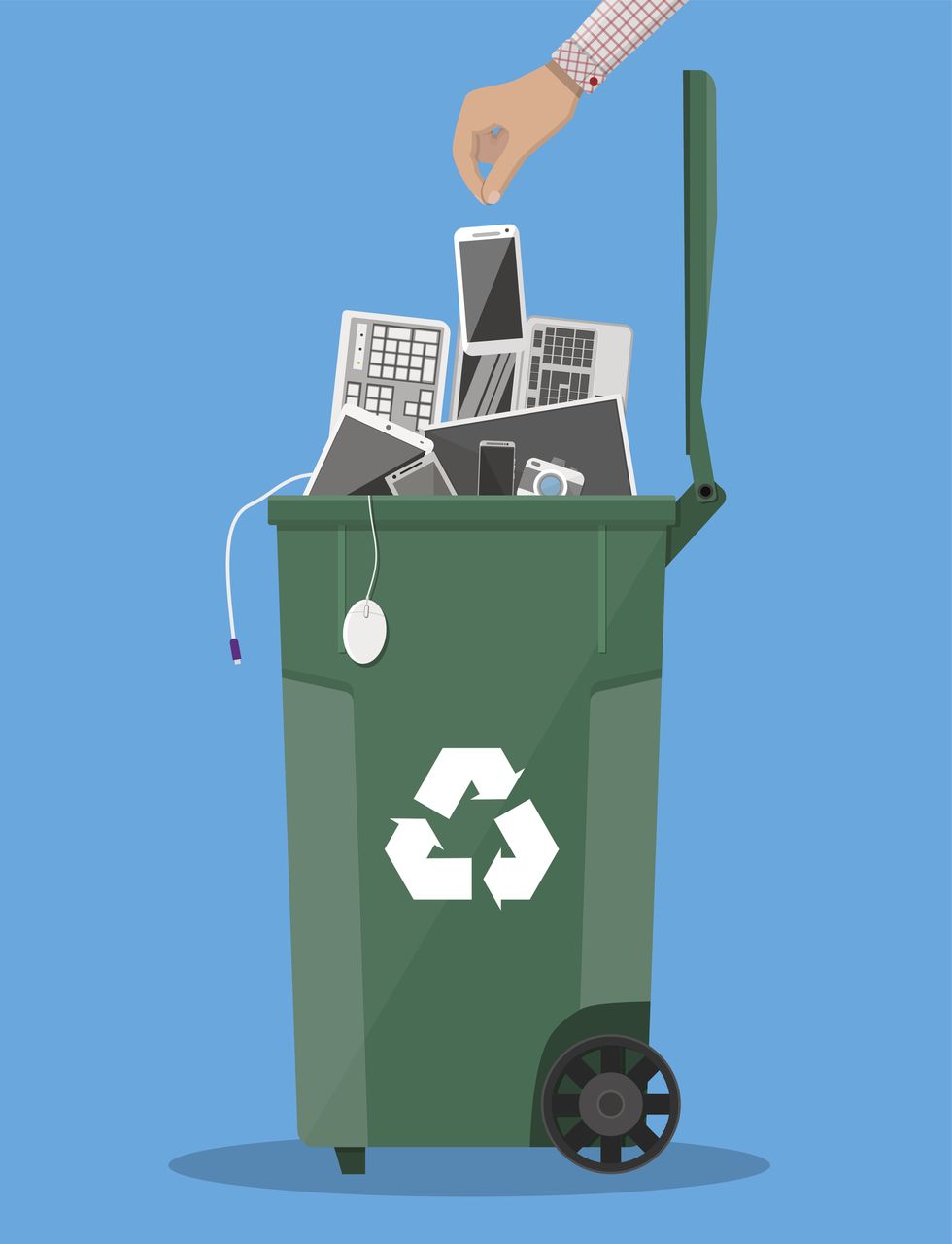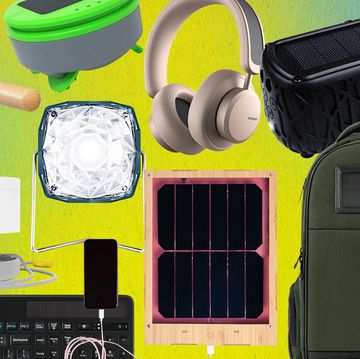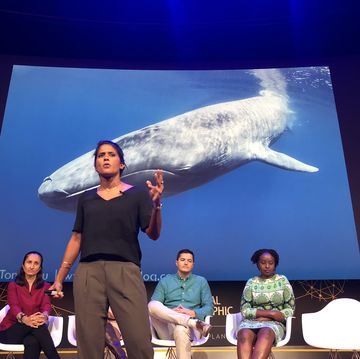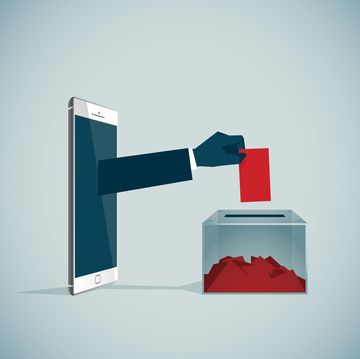When the U.S. screeched to a halt in March 2020 as a result of the pandemic, technology spared the world from a complete and total shutdown. From Zoom meetings to e-commerce to VR concerts, technology kept us connected and kept businesses running. We could continue taking workout classes via Instagram Live and Zoom, seeing our doctors face to face through video calls, and even hanging out together in virtual chat rooms. For those of us who live alone, it spared us from complete aloneness.
Given the reach technology has in every facet of our lives, and how central it’s been to our survival during Covid-19, Shondaland wanted to explore where tech is today, how we relate to it, where it’s headed, and the ways it will reshape our lives in the near future.
It’s a hot summer day. You pull the tab and open a sweat-dripping can of sparkling water. After finishing it you go to throw it away. Instinctively and without thinking you avoid the trash can and look for the place indicated for recyclable products like aluminum and paper.
This instinctive recycling reflex wasn’t always around. That journey has been ongoing in the U.S. since 1981 when New Jersey became the first U.S. city to mandate recycling. Now, both access to curbside recycling and awareness about the importance of recycling aluminum, plastics, and paper has increased dramatically.
Technology: A Shondaland Series
While recycling is increasing for simple and disposable products like drink cans, what about complex technology like personal computers and mobile phones?
These types of products weren’t around in the 80s, but they have grown in volume substantially over the last decade. Not only volume, but the amount of time we use these new gadgets is also rapidly declining — constantly in search of new features and hardware capabilities with short upgrade cycles.
What’s e-waste?
These electronics become e-waste when we try to get rid of them. The term e-waste stands for electronic waste and generally refers to electronic devices that no longer work or function. Although these devices might be trash because they no longer work as intended, they shouldn’t be thrown into the garbage and, in certain states like California, are illegal to dispose of without properly recycling.
These types of products are e-waste because they often aren’t made up by just one or two different types of materials. They are much more complex and include a wide range of materials, occasionally ones that are hazardous to people and the environment, such as lead, mercury, and cadmium.
There’s not a standard defined list of e-waste items, but mobile phones, TV sets, microwaves, computers, and even light bulbs all fall under this category. To make it easy, if it has a cord, cable, or battery, it’s likely e-waste.
Why should anyone care about e-waste?
The environment is the biggest beneficiary of properly recycling e-waste. If these items aren’t properly handled, they can release harmful gases and toxins into the air and soil — harmful for people and the planet.
“Electronics are the fastest growing waste stream in the world and it is estimated only ~30% of electronics are recycled in the U.S. annually,” Ana Pacheco, Quality Assurance Manager at Homeboy Electronics Recycling told Shondaland.
Properly dismantling electronic devices can also help recover materials like copper and gold to prevent needing to destroy areas of land in order to mine for these finite resources in the future.
Recycling in general is about protecting our planet from being destroyed. Recycling e-waste is no different. As we produce and use more electronic devices the need to properly handle them only intensifies. If you care about air quality, protecting wildlife, and guarding natural resources, among other things, then caring about e-waste recycling goes hand-in-hand.
What can I do with my electronics instead of trash them?
The now old recycling adage of reduce, reuse, recycle, still applies for electronics. In this case, applications of those terms may also be more tangible. While it’s hard to reuse every old can yourself after the drink is gone, the potential to reuse or donate an electronic device after its utility has expired for you is much greater.
Electronic devices such as phones, computers, and TVs, may still have some monetary value. Online trade-in services like Gazelle and Decluttr will accept older phones and give you cash for them. Don’t expect the same amount back that you paid, but a lot of phones three years old and newer will hold some monetary value.
Some of these trade-in services, which there are plenty, will also accept devices even if they don’t work or have cracked screens.
Recycling old electronics is often a pain because there’s no standardized curbside pick up of e-waste. Still, Apple, as one example is willing to accept old electronics and recycle them on your behalf. The company will accept products beyond its own. Best Buy is another retailer that will accept items to recycle — up to three per household per day.
If you have a device that is too big to ship or isn’t accepted, state and local governments will have locations that can accept these items. California has a website that will show sites near your location.
Alternatively, Homeboy Electronics Recycling, based in Los Angeles, is an option looking to improve communities. It provides ample methods for getting electronics to them including drop-off, pick-up, and mail-in. Plus, the Homeboy network of services, including electronics recycling, works with people who face systemic barriers to employment to hire them for permanent jobs.
For items that do work fine, but are too old to sell to trade-in services, donating them may be a solution that could help benefit others. Goodwill is another non-profit that accepts electronic donations. It will resell those devices in its stores which goes towards helping people in local communities with job training and other programs.
What’s the solution for e-waste?
“Only 25 states have electronics recycling laws, so there are no federal laws mandating all electronics must be recycled, which can make it difficult for those in states with no electronics recycling laws to properly dispose of their electronics,” said Pacheco.
That really emphasizes that beyond coming up with ways to reuse and recycle old electronics after the fact, the important way to deal with e-waste is to consider its impacts before manufacturing or purchasing products — reduce.
Companies that consider how its products are made, whether what they manufacture is easy to disassemble, are in positions to offer consumers better solutions for eventually dealing with e-waste.
Nimble, a company that started off making portable batteries and accessory cables, is one example of this growing trend. A key part of its messaging, since its founding, has been about its impact on the environment before manufacturing and after its life is over.
“We believe if Nimble is introducing new electronics into the world, it's our responsibility to also take as much out of it” Julie Kao, Director of Operations for Nimble told Shondaland. “We wanted to be proactive on this issue by making e-waste recycling and awareness a core part of our identity. Our customers' support for our approach is strongly reflected in their feedback. It's helped us build a strong community, and has hopefully encouraged more manufacturers to take e-waste seriously.”
In terms of real and practical solutions that companies should do, Kao also said, “First, products must be built to last. Planned obsolescence is the biggest contributor to e-waste. Second, products should be made with recycled materials. This not only helps conserve natural resources, but improves overall recycling capabilities due to increased demand for recycled materials.”
If your favorite company hasn’t mentioned anything about how it considers or handles e-waste, shoot them a message on social media and ask. Most companies want feedback and this is a simple way to let it know people care about how the products are made and what happens after that one-time purchase.
Recycling is a hard battle, but it really is an individual team sport like baseball where we can make a difference by each doing our own part.
Tyler Hayes is an early adopter and technology writer based in California who’s contributed to Fast Company, BuzzFeed, and Billboard, among others.
Get Shondaland directly in your inbox: SUBSCRIBE TODAY


















